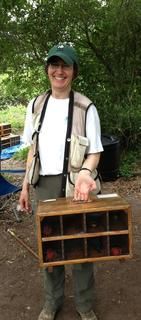Dr. Meg Hatch, associate professor of biology at Penn State Worthington Scranton, has been named an elective member of the American Ornithology Union (AOU). Elective Members are nominated based on their significant contribution to ornithology and/or service to the AOU.
A member of the AOU since 1994, she has attended many AOU meetings and all but one North American Ornithological Conference (NAOC) meeting. She has also served on its Young Professionals Committee, judged student posters at most of the NAOC meetings she attended, and served on the Wilson Ornithological Society Council from 2011-2014, chairing their Student Travel Awards Committee.
Dr. Hatch, who also serves as program coordinator for the science program at Worthington Scranton, conducts research on songbirds and has had her work published in numerous journals and professional publications including the Journal of Field Ornithology, the Journal of Avian Biology, and The Condor.
Her interests are in life-history tradeoffs in songbirds, studying age and parental behavior, and more recently, aspects of migration and ecoimmunology. Song sparrows, house sparrows and gray catbirds are some of her focal species.
She received her bachelor's degree in wildlife and fisheries biology from the University of California, Davis; her master's degree in Wildlife Ecology from the University of Wisconsin-Madison; and her doctorate in biology from the University of Kentucky.
Dr. Hatch is also the recipient of several campus and University awards: the Dr. Richard J. and Sally Matthews Award for Scholarly Activity; the Matthews Faculty Research Endowment; the President's Fund for Undergraduate Research; the Greater Scranton Penn State Chapter Research Endowment; and is a three-time recipient of Penn State's Research Development Grants.
The AOU promotes itself as a gateway to ornithological societies and resources that promote the understanding, appreciation, and conservation of bird species and their populations. Learn more at www.americanornithology.org
